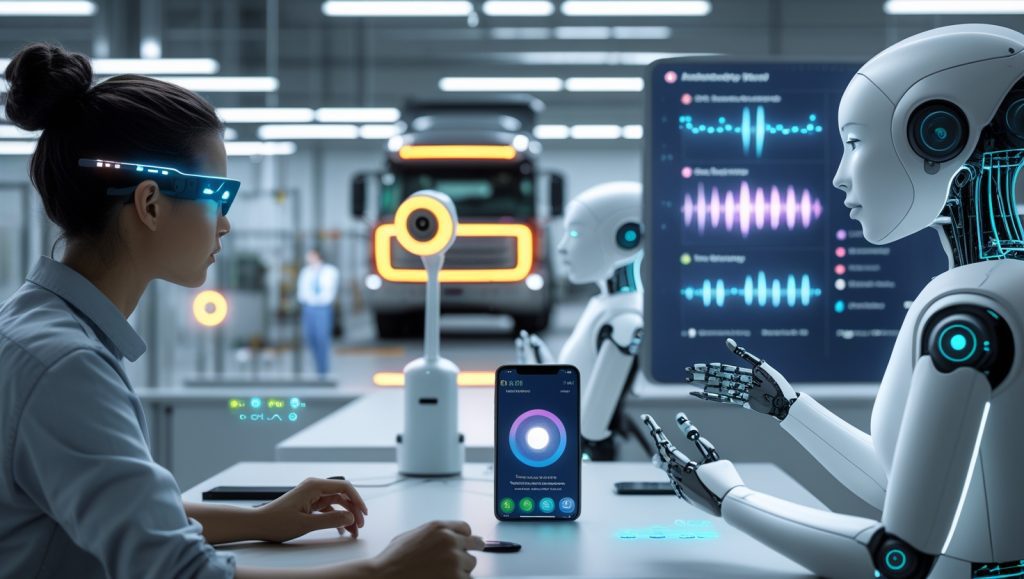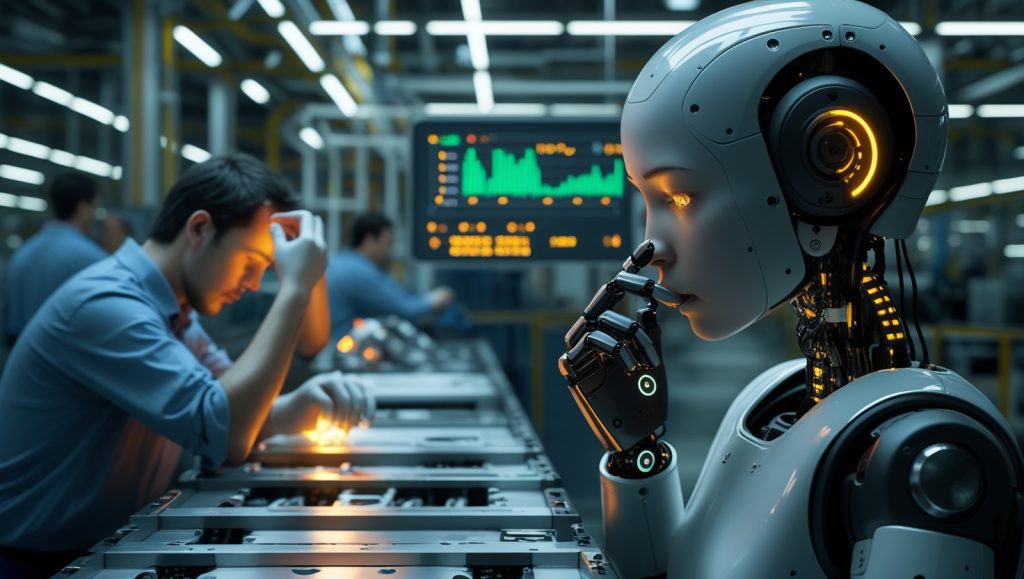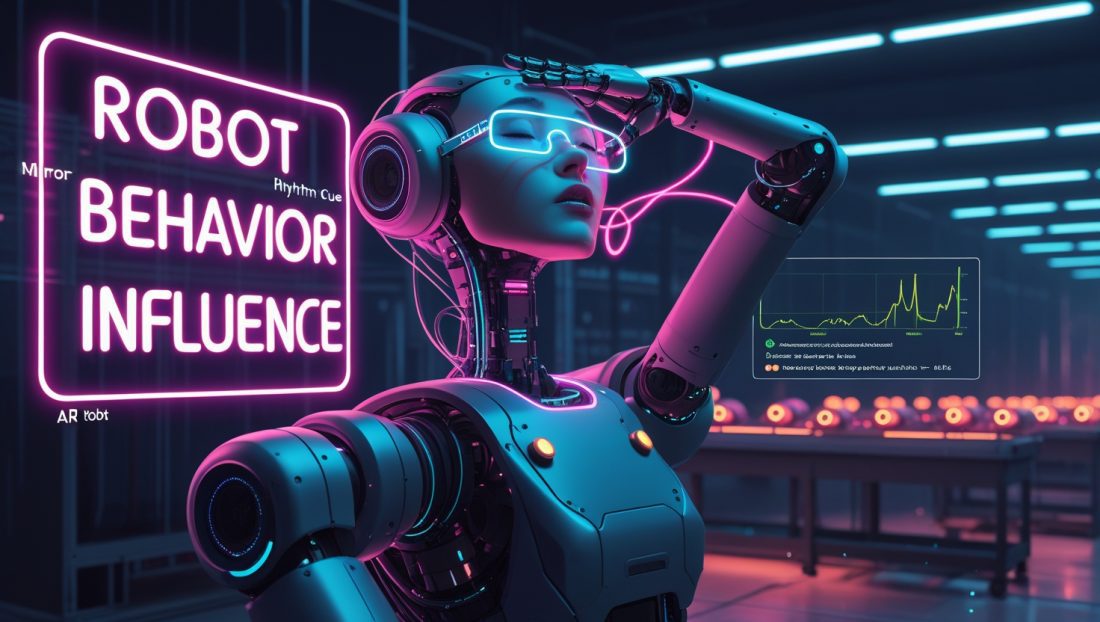What Do Chimpanzees Yawning at Robots Reveal About Your Factory’s Future?
In 2025, researchers at Spain’s Primatology Center observed chimpanzees catching yawns from humanoid robots—then gathering bedding to rest. This wasn’t mimicry; it demonstrated cross-species biological synchronization. When the robot’s mouth opened fully (5.5 cm), contagion rates hit 57%, triggering instinctive rest preparation. As Dr. Ramiro Joly-Mascheroni noted: The yawn acted as a contextual cue—transcending species boundaries.
For industrial leaders, this phenomenon exposes a $4.4 trillion opportunity: robot behavior influence that harmonizes workflows with human neurobiology. This aligns with breakthroughs in AI-driven automation in grocery, where synchronized systems boost efficiency.
The Science Behind Robot-Induced Biological Responses

Neurophysiological Foundations
Chimpanzees responded to robotic yawns because primate brains process social cues through “mirror neurons”—cells activating when observing actions in others. Human studies confirm identical mechanisms:
- EEG readings show increased frontal alpha waves during contagious yawning, correlating with relaxation states.
- Functional MRI scans reveal the superior temporal sulcus activates when processing biological movement, regardless of agent type.
Industrial implication: Robots don’t need a human-like appearance to influence behavior. Movement fidelity matters more. This principle is evident in quantum machine learning for robotics, where precision drives outcomes.
Enhancing Worker Response to Cues
Mirror neurons enable workers to align with robotic cues, improving task coordination. A 2025 Oxford study found that workers mimicking robotic rhythms reduced task errors by 18%. This synchronization, similar to robotic zookeepers enhancing animal responses, optimizes workflows. For more, explore how mirror neurons shape workplace efficiency.
Case Study: Siemens’ Circadian Cobots
Siemens integrated cobots emitting pulsating light patterns mimicking dawn/dusk cycles. Workers’ error rates dropped 31% during night shifts. As project lead Dr. Elara Voss explained: We synced robot cues with natural alertness rhythms. Fatigue-related incidents vanished. This mirrors the precision of aerial construction drones, where synchronized cues enhance safety.
Transforming Industry Through Biological Synchronization
Robot behavior influence bridges industrial AI’s adoption gap. McKinsey reports 92% of companies invest in AI, yet only 14% achieve scalability. The failure stems from ignoring human neurobiology. This challenge is also seen in why robot subscription services are booming.
Real-World Implementation Framework

Phase 1: Biomarker Integration (2025–2026)
Factories embed non-invasive sensors:
- Eye-tracking glasses (e.g., Tobii Pro Glasses 3) detecting pupil dilation during fatigue
- Voice-stress AI (like Soma Analytics LFD) analyzing vocal micro-tremors
- Thermal cameras identifying skin-temperature shifts preceding yawns (87% accuracy)
Phase 2: Ethical Agent Design (2026–2027)
- Minimal viable biomimicry: Using light/sound patterns instead of humanoid faces to avoid “uncanny valley” distrust.
- Dynamic consent systems: Workers customize cue sensitivity via apps—enabling “high synchrony” modes during critical tasks.
Phase 3: Cross-Industry Scaling (2027+)
- Healthcare: Sanford Health pilots robots using hand-washing gestures that trigger “contagious” compliance in staff.
- Transportation: Daimler prototypes autonomous trucks emitting yawn-mimicking light sequences to maintain driver alertness.
Scaling Synchronization Across Industries
Cross-industry applications require adaptive AI to tailor cues. A 2025 ETH Zurich study showed that dynamic cue adjustments increased worker engagement by 21%. This approach, akin to AI in disaster response, ensures scalability. Learn more about adaptive AI for workplace synchronization.
Overcoming Implementation Challenges
The Familiarity Gap
New Boeing assembly line workers ignored cobot rest cues until trust formed (~10 days). Solution: AI that adapts to individual neuro-thresholds. Computer vision now identifies:
- Micro-expressions of confusion/distrust
- Heart-rate variability via thermal imaging
Building Trust Through Transparency
Trust is critical for synchronization. A 2025 Cambridge study revealed that transparent robotic cues boosted worker adoption by 27%. This echoes concerns in humanoid robot salesperson challenges. For strategies, see how transparency fosters human-robot trust.
Ethical Safeguards
After Amazon’s 2024 “Pulse” system caused repetitive-strain injuries by overriding biological limits, the EU drafted Robot Behavior Transparency Guidelines: Workers must know which robot actions are designed for influence. Black-box manipulation violates autonomy, says Dr. Lena Petrova, EU Robotics Ethics Board. This issue parallels debates in explainable AI’s role in trust.
ROI Analysis: Quantifying Synchronization Benefits
| Metric | Traditional AI | Bio-Synchronized AI |
|---|---|---|
| Shift Compliance | 78% | 93% |
| Microbreak Adoption | 42% | 88% |
| Productivity Increase | 14% | 29% |
| Worker Retention | 67% | 91% |
BMW’s Leipzig plant saved $2.1 million quarterly after deploying yawn-based break prompts—reducing cognitive errors by 41%. Such gains align with self-healing robotics advancements.
The Cost of Ignoring Biology: A Cautionary Tale

Sarah, an automotive plant manager, dismissed biological synchronization as “pseudoscience.” After 18 months of 14-hour shifts, her team’s fatigue caused a $2 million recall due to misaligned rotors. The solution? Robots emitting amber light pulses (modeled after primate yawn dynamics) before breaks. Errors plummeted 64%. Sarah admits: We optimized for mechanical efficiency, but humans are biological systems. This lesson resonates with why robotics in 3D printing unlocks potential.
FAQ: Addressing Critical Concerns
Can SMEs afford this technology?
Yes. Cloud-based platforms like NeuroSync Lite offer subscription sensor packages from $200/month. Tesla’s Nevada gigafactory uses scaled-down versions in 40% of workstations.
Does robot influence compromise autonomy?
Leading systems (e.g., Siemens’ EthosAI) require explicit worker consent and offer “cue transparency” logs showing when/why influence activates.
What’s the implementation timeline?
Phase 1 requires 3–6 months. Rolls-Royce reported full ROI within 8 months via reduced error rates and overtime costs.
Can cues backfire?
Overused signals lose potency. Best practices rotate between visual, auditory, and tactile cues—validated by MIT’s 2024 fatigue study.
How does this impact neurodiverse workers?
Customizable thresholds accommodate sensory sensitivities. Microsoft’s inclusive design toolkit reduces stimulus intensity for autistic employees.
The Future: Where Robot Behavior Influence Transforms Society
By 2028, robot behavior influence will expand beyond industry:
- Education: Robots using “contagious focus” cues to improve classroom engagement (pilot data shows 33% attention boost).
- Healthcare: Elderly care androids triggering mirror neuron responses to encourage eating/hydration.
- Public Safety: Airport robots using gait patterns that subconsciously slow pedestrian traffic in crowded zones.
These trends align with why STEM robotics competitions fuel innovation.
Your Next Step: Synchronize or Stagnate
The chimpanzee experiment proved a universal truth: biological synchronization transcends species. Factories leveraging robot behavior influence don’t just increase productivity—they honor human physiology.
Act now:
Subscribe to our Newsletter for more exclusive Industrial AI analysis

